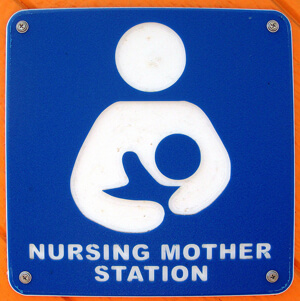CEUFast Course Overview: Breastfeeding
Photo by: Arturo Sotillo (Flickr)
Designated public places offering new mothers privacy while they're out encourage women to breastfeed their babies.
CEUFast Course Overview: Breastfeeding
One of the most natural things to a new mother and her infant is breastfeeding, yet many of America's mothers do not breastfeed their newborns. Lack of support from family and employers, a failure to understand the importance and benefits of breastfeeding, and misconceived stigmas associated with the act are all cited as reasons why breastfeeding has fallen out of favor. The physical and emotional benefits for both child and mother significantly outweigh the reasons for failing to breastfeed, and we health-care practitioners have a responsibility to adequately educate and encourage new mothers to breastfeed their babies. CEUFast offers a breastfeeding certification course designed to help nurses guide their patients into this healthy and loving step of motherhood.
It might seem odd that I am encouraging you to take breastfeeding courses, but I can assure you that unless you've had a child and breastfed yourself, it's not as easy as it might seem. The American Academy of Pediatrics, the Centers for Disease Control, the U.S. Department of Agriculture, the surgeon general, and first lady Michelle Obama, through her Let's Move campaign, have all initiated a call to action encouraging America's health-care professionals to encourage mothers to breastfeed their infants. Why are so many key figures in Washington concerned about breastfeeding? Let's look at some information that just might surprise you.
Infants who are breastfed for the first six months to one year of their lives experience a significant reduction in the severity and occurrences of:
- Allergies and eczema
- Celiac disease
- Diabetes
- Ear infections
- Gastroenteritis
- Inflammatory bowel disease
- Leukemia and lymphoma
- Lower respiratory infections
- Necrotizing entercolitis
- Obesity
- Sudden Infant Death Syndrome (SIDS)
But wait, there's more! Breastfeeding isn't only healthy for the baby; it is also healthy for the mother. Breastfeeding a newborn baby protects the mother against:
- Breast cancer
- Cardiovascular disease
- Hyperlipidemia
- Hypertension
- Ovarian cancer
- Postpartum blood loss and hemorrhage
- Type II diabetes
And the real shocker? A published 2010 study concluded that around 900 deaths per year could be prevented if 90 percent of America's mothers would breastfeed their babies during their first six months of life -- and it is important to note that a majority of those 900 deaths are the infants themselves. When you consider the life-saving health benefits linked to breastfeeding, it is truly a wonder why more American women aren't breastfeeding their children, and this is where we health-care professionals come in and why we need to take a breastfeeding certification course.
The purposes and objectives of breastfeeding courses are to teach health-care practitioners why breastfeeding is important to both the infant and mother; what national, international, and professional mandates are in place for breastfeeding mothers; and about the numerous barriers discouraging women from breastfeeding. Simply put, if you are armed with extensive knowledge about breastfeeding, you can share that knowledge with your patients.
Alongside the purposes and objectives I just listed, the CEUFast breastfeeding certification course also includes coursework on:
- Your role as a health-care practitioner in breastfeeding.
- The nutritional benefits of human breast milk.
- Teaching a new mother how to breastfeed her baby, including positioning, how often, and how much time on each breast.
- Teaching a new mother how to care for herself and her breasts while she's breastfeeding.
- Clarification on the use of pacifiers and supplements.
- Teaching the new mother how to wean her child when the child is old enough to stop breastfeeding.
- Illnesses and special circumstances surrounding breastfeeding.
In just reading this blog post, you can see there is a lot to learn when it comes to breastfeeding a newborn baby, and new mothers rely on their health-care professionals to help them get the hang of nursing their babies. When you take breastfeeding courses to educate yourself on the importance and techniques of breastfeeding, you aren't the only one who benefits. Your patients and their babies will greatly benefit as well!




